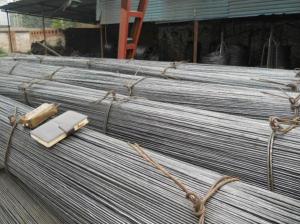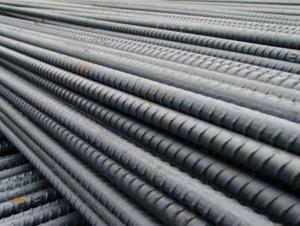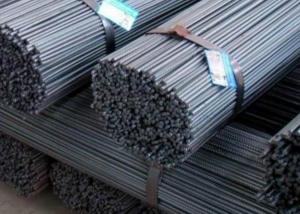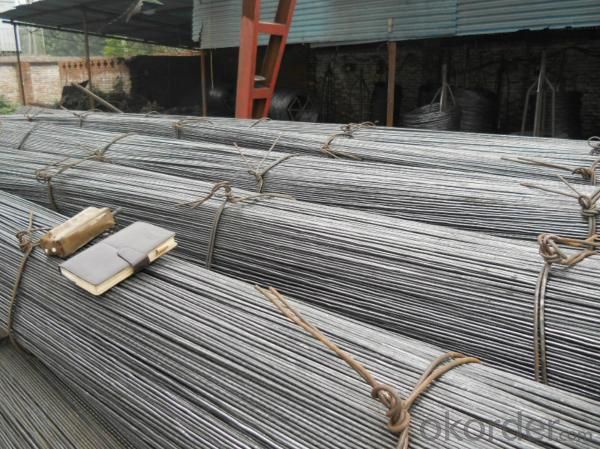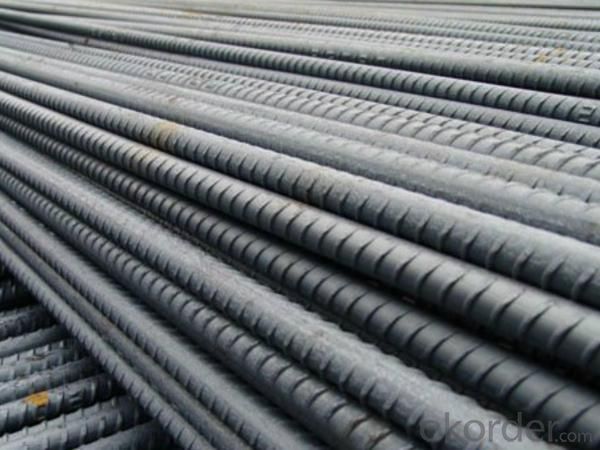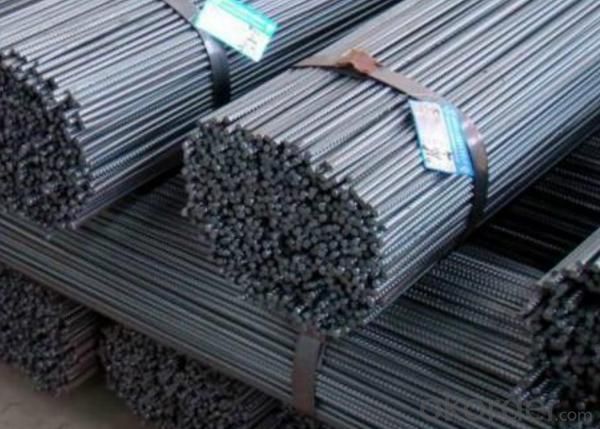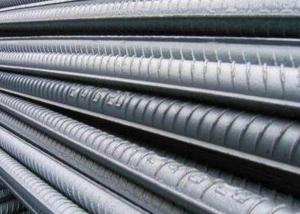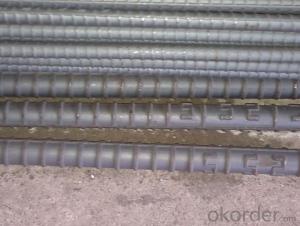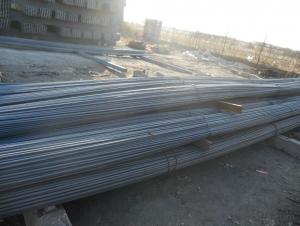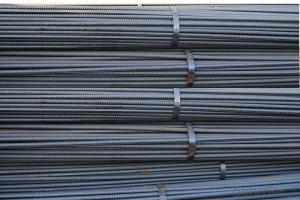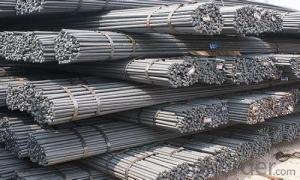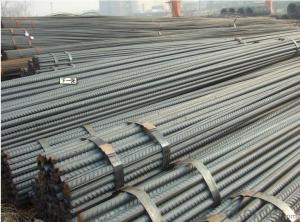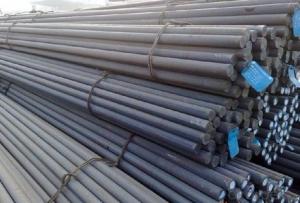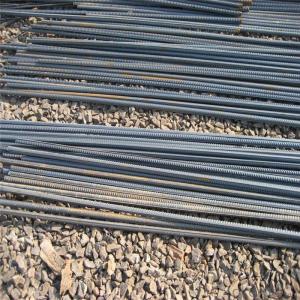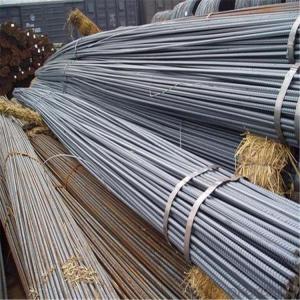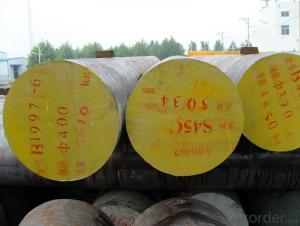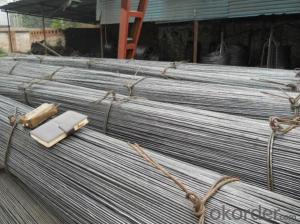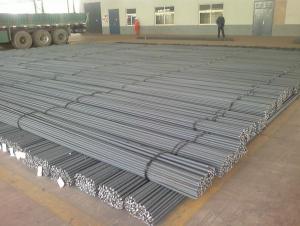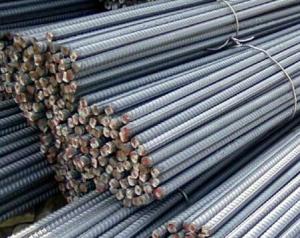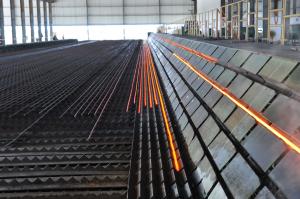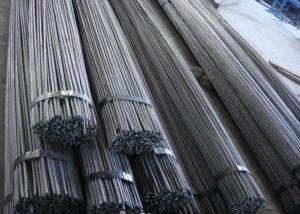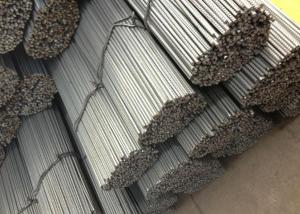HRB500 Deformed Steel Bar
- Loading Port:
- China Main Port
- Payment Terms:
- TT or LC
- Min Order Qty:
- 25MT m.t.
- Supply Capability:
- 800000/YEAR m.t./month
OKorder Service Pledge
OKorder Financial Service
You Might Also Like
Specifications of HRB500 Deformed Steel Bar:
Standard | GB | HRB500 |
Diameter | 6mm,8mm,10mm,12mm,14mm,16mm,18mm,20mm, 22mm,25mm,28mm,32mm,36mm,40mm,50mm | |
Length | 6M, 9M,12M or as required | |
Payment term | TT or L/C | |
Application | mainly used in construction industry to reinforce concrete structures and so on | |
Quality | First quality, the goods are from Chinese big manufacturers. | |
Type | Hot rolled deformed steel bar | |
Brand name | DRAGON | |
Chemical Composition: (Please kindly find our chemistry of our material based on HRB500 as below for your information)
Grade | Technical data of the original chemical composition (%) | ||||||
C | Mn | Si | S | P | V | ||
HRB500 | ≤0.25 | ≤1.60 | ≤0.80 | ≤0.045 | ≤0.045 | 0.08-0.12 | |
Physical capability | |||||||
Yield Strength (N/cm²) | Tensile Strength (N/cm²) | Elongation (%) | |||||
≥500 | ≥630 | ≥12 | |||||
Theoretical weight and section area of each diameter as below for your information:
Diameter(mm) | Section area (mm²) | Mass(kg/m) | Weight of 12m bar(kg) |
6 | 28.27 | 0.222 | 2.664 |
8 | 50.27 | 0.395 | 4.74 |
10 | 78.54 | 0.617 | 7.404 |
12 | 113.1 | 0.888 | 10.656 |
14 | 153.9 | 1.21 | 14.52 |
16 | 201.1 | 1.58 | 18.96 |
18 | 254.5 | 2.00 | 24 |
20 | 314.2 | 2.47 | 29.64 |
22 | 380.1 | 2.98 | 35.76 |
25 | 490.9 | 3.85 | 46.2 |
28 | 615.8 | 4.83 | 57.96 |
32 | 804.2 | 6.31 | 75.72 |
36 | 1018 | 7.99 | 98.88 |
40 | 1257 | 9.87 | 118.44 |
50 | 1964 | 15.42 | 185.04 |
Usage and Applications of HRB500 Deformed Steel Bar:
Deformed bar is widely used in buildings, bridges, roads and other engineering construction. Big to highways, railways, bridges, culverts, tunnels, public facilities such as flood control, dam, small to housing construction, beam, column, wall and the foundation of the plate, deformed bar is an integral structure material. With the development of world economy and the vigorous development of infrastructure construction, real estate, the demand for deformed bar will be larger and larger..
Packaging & Delivery of HRB500 Deformed Steel Bar:
Packaging Detail: products are packed in bundle and then shipped by container or bulk vessel, deformed bar is usually naked strapping delivery, when storing, please pay attention to moisture proof. The performance of rust will produce adverse effect.
Each bundle weight: 2-3MT, or as required
Delivery Detail: within 45 days after received advanced payment or LC.
Label: to be specified by customer, generally, each bundle has 1-2 labels
Trade terms: FOB, CFR, CIF
Deformed Steel Bar in stock
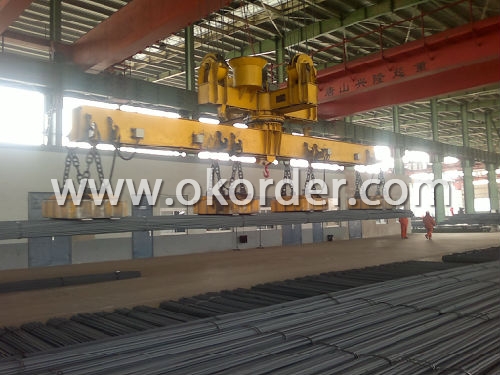
Deformed Steel Bar in testing
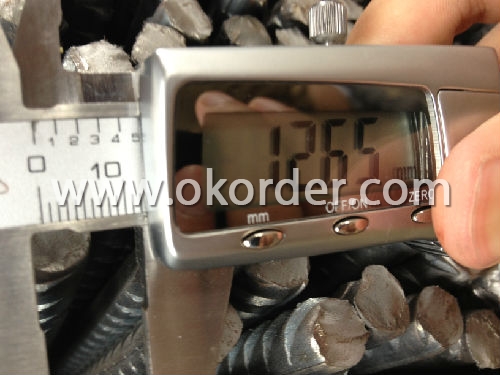
Note:
1. Our products are produced according to national standard (GB), if not, supply according to national standards (GB) or agreement as customer required.
2. Other Grade and Standard Deformed Steel Bar we can supply:
Grade: GR40/GR60, G460B/B500A/B500B/B500C,BST500S
Standard: ASTM, BS, DIN
The Minimum Order Quantity of these products is high, and need to be confirmed.
3. We can not only supply Deformed Steel Bar; if you need anything about building materials, please contact us for further information.
4. Please send us your detail specifications when inquire. We will reply to you as soon as possible. We sincerely hope we can establish a long stable business relationship.
- Q: What are the common misconceptions about steel rebars?
- One common misconception about steel rebars is that they are prone to rusting and corrosion. However, rebars are typically made with a protective coating or are embedded within concrete, which prevents direct exposure to moisture and reduces the risk of rusting. Another misconception is that thicker rebars always provide better reinforcement. In reality, the appropriate size and spacing of rebars depend on the specific structural requirements and engineering calculations, rather than just thickness.
- Q: What is the role of steel rebars in preventing concrete spalling due to fire?
- The role of steel rebars in preventing concrete spalling due to fire is crucial. Spalling is the process where concrete cracks, breaks, or flakes off under extreme heat, such as in a fire. Steel rebars, also known as reinforcement bars, are embedded within the concrete structure to enhance its strength and durability. During a fire, the temperature can rise rapidly, causing the moisture within the concrete to turn into steam. This steam generates pressure within the concrete, leading to spalling. However, the presence of steel rebars helps to mitigate this issue. Steel has a higher melting point than concrete and possesses excellent thermal conductivity. When exposed to high temperatures, the steel rebars conduct and dissipate the heat more efficiently compared to the surrounding concrete. This heat transfer helps to minimize the temperature gradient within the concrete, reducing the risk of spalling. Furthermore, steel rebars act as a reinforcement to hold the concrete together. In the event of spalling, the rebars help to maintain the structural integrity of the concrete by preventing it from completely disintegrating. They provide additional strength and support to the concrete, making it more resistant to cracking and breaking. In summary, steel rebars play a vital role in preventing concrete spalling due to fire. They dissipate heat, minimize temperature gradients, and provide structural support to the concrete. By enhancing the fire resistance of the concrete, steel rebars contribute to the overall safety and longevity of the structure.
- Q: What are the different types of steel rebars used in road construction?
- There are typically two types of steel rebars used in road construction: plain steel bars and deformed steel bars. Plain steel bars are smooth and have no ridges or deformations. Deformed steel bars, on the other hand, have ridges, protrusions, or other patterns on their surface to improve the bond strength between the rebar and the surrounding concrete. Both types of rebars are commonly used in road construction to reinforce and strengthen the concrete structures.
- Q: Can steel rebars be used in the construction of offshore oil platforms?
- Yes, steel rebars can be used in the construction of offshore oil platforms. Steel rebars are commonly used in construction to reinforce concrete structures and provide additional strength and durability. In the case of offshore oil platforms, steel rebars are used to reinforce the concrete foundations and structures of the platform, helping to withstand the harsh environmental conditions and the weight of the equipment and infrastructure on the platform. The steel rebars are designed to resist corrosion and are typically coated with epoxy or other protective coatings to prevent rusting in the corrosive marine environment. Additionally, steel rebars can be custom-designed to meet the specific requirements of the offshore oil platform, ensuring they provide the necessary strength and stability.
- Q: What is the maximum length of straight steel rebars available in the market?
- The maximum length of straight steel rebars available in the market can vary depending on the specific supplier and region. However, common lengths range from 6 meters (20 feet) to 12 meters (40 feet).
- Q: What specifications should be used for the three - step steel electroslag pressure welding electrode?
- Three - step steel electroslag pressure welding electrode with 3mm diameter wire can be.
- Q: How do steel rebars affect the weight of a concrete structure?
- The weight of a concrete structure can be significantly impacted by steel rebars. These rebars, typically made of steel, reinforce the concrete and enhance its strength and durability. They are primarily placed in areas of concrete under tension, such as the bottom of beams or the middle of slabs. While the presence of steel rebars does add to the overall weight of the structure, it also allows for the use of less concrete. By adding reinforcement, the concrete can withstand higher loads and stresses, reducing the need for excessive amounts of concrete. As a result, the structure becomes lighter. Furthermore, steel rebars enable the design and construction of more slender and efficient structures. The increased strength provided by the rebars allows for longer spans and thinner sections, which reduces the dead load. This not only decreases the weight of the structure but also offers more flexibility in architectural and structural design. In addition, the weight of a concrete structure is a critical consideration, particularly in high-rise buildings or long-span structures. Excessive weight can strain the foundation and increase construction costs. By utilizing steel rebars, the weight of the concrete structure can be optimized without compromising its structural integrity. To sum up, steel rebars play a crucial role in reducing the weight of concrete structures. They enable the use of less concrete while maintaining the required strength, resulting in lighter and more efficient structures. The use of rebars also provides flexibility in design and reduces construction costs associated with excessive weight.
- Q: What is the effect of impurities on the corrosion resistance of steel rebars?
- Impurities can have a significant effect on the corrosion resistance of steel rebars. Steel rebars are primarily composed of iron and carbon, but impurities such as sulfur, phosphorus, and silicon can be present in varying amounts. Sulfur, for example, is a common impurity found in steel. It can react with water and oxygen to form sulfuric acid, which accelerates the corrosion process. This acid attack can cause the rebars to deteriorate faster, reducing their overall strength and durability. Phosphorus is another impurity that can negatively impact the corrosion resistance of steel rebars. It can promote the formation of localized corrosion sites, known as pitting, which can lead to the development of rust and eventual structural damage. Silicon, although generally considered a beneficial element in steel production, can also have an adverse effect when present in excessive amounts. Higher silicon levels in rebars can lead to the formation of a protective oxide layer, but this layer can sometimes be porous, allowing the penetration of corrosive agents and resulting in corrosion. Overall, the presence of impurities in steel rebars can compromise their corrosion resistance. It is crucial to ensure that the steel used in construction meets the specified standards and contains minimal impurities. Additionally, proper maintenance and regular inspection of rebars are essential to identify and address any potential corrosion issues before they lead to significant damage or structural failures.
- Q: Can steel rebars be used in historical buildings restoration?
- Yes, steel rebars can be used in the restoration of historical buildings. Steel rebars are commonly used in construction and can provide structural reinforcement to strengthen the existing structures of historical buildings. When carefully implemented, steel rebars can help restore the stability and integrity of these buildings while preserving their historical significance. However, it is important to consider the specific requirements and guidelines for historical building restoration to ensure that the use of steel rebars does not compromise the authenticity or aesthetic value of the structure. Proper planning, consultation with preservation experts, and adherence to conservation principles are essential to successfully incorporate steel rebars in the restoration process of historical buildings.
- Q: Are steel rebars susceptible to corrosion?
- Steel rebars can be corroded, as corrosion is a natural occurrence when steel is exposed to moisture, oxygen, and other environmental factors. In concrete structures, the rebars are exposed to the elements and can come into contact with water or moisture, resulting in the formation of rust. This rust weakens the rebars and can ultimately compromise the concrete's structural integrity. Preventive measures can be taken to avoid corrosion, including applying a protective coating or using rebars made of corrosion-resistant steel. It is crucial to regularly maintain and inspect concrete structures to promptly identify and address any signs of corrosion.
1. Manufacturer Overview
| Location | Hebei, China |
| Year Established | 2002 |
| Annual Output Value | Above US$ 400 Million |
| Main Markets | South Asia; Middle East;Southeast Aisa |
| Company Certifications |
2. Manufacturer Certificates
| a) Certification Name | |
| Range | |
| Reference | |
| Validity Period |
3. Manufacturer Capability
| a) Trade Capacity | |
| Nearest Port | Tianjin |
| Export Percentage | 60%-80% |
| No.of Employees in Trade Department | 11-20 People |
| Language Spoken: | English; Chinese |
| b) Factory Information | |
| Factory Size: | Above 100,000 square meters |
| No. of Production Lines | 2 |
| Contract Manufacturing | OEM service offered |
| Product Price Range | average |
Send your message to us
HRB500 Deformed Steel Bar
- Loading Port:
- China Main Port
- Payment Terms:
- TT or LC
- Min Order Qty:
- 25MT m.t.
- Supply Capability:
- 800000/YEAR m.t./month
OKorder Service Pledge
OKorder Financial Service
Similar products
Hot products
Hot Searches
Related keywords
